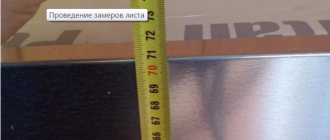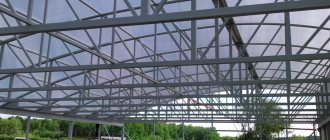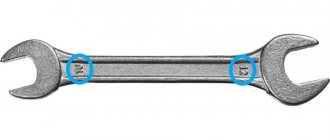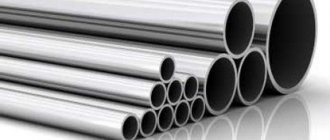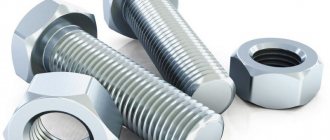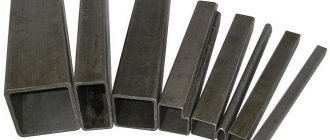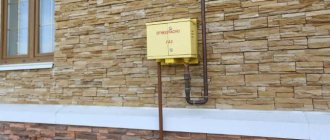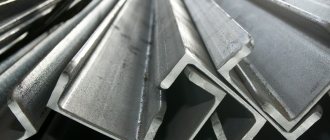How to use the calculator
1. Select the type, grade of material and type of rolled metal; 2. Indicate its characteristics in the appropriate fields and click the “Calculate” button; 3. The calculator will calculate the weight or length of the product; 4. If you entered the parameters incorrectly and the calculator generated an error during the calculations, click on the button for selecting the rental type and calculate again.
See also: Regional delivery calculator
Dear Clients! We suggest you use the metal calculator provided. It will help you calculate how much a particular type of metal product will weigh according to the characteristics with the specified measurements, or what the length of the selected product will be with the specified weight.
If you have any questions, you can call our managers.
Areas of application
Aluminum alloys, with their low specific gravity, have sufficient strength and high corrosion resistance. Therefore, aluminum pipes are used in a variety of areas:
- In construction for laying cable communications, installing facade systems with suspended facades.
- For window and door structures, display frames, partitions, railings, decorative grilles and fences; suspended ceilings and wall coverings with finishing materials.
- Furniture is made from aluminum corrugated pipe; in trade, exhibition, and advertising equipment, profiles made of aluminum alloys are simply irreplaceable.
- Frames of small structures or small architectural forms are made from aluminum profiles - gazebos, canopies, awnings, greenhouses, small hangars, fences.
- Often used for air duct components.
- For all kinds of products used in everyday life: almost eternal stepladders and ladders, decorative items, awnings and awnings, cornices, shelves, whatnots, cages, enclosures.
- Sports equipment, frames of small and inflatable boats, etc.
- Aluminum pipes, including profile ones, are widely used in industry - oil, shipbuilding, automotive, aviation industry, and in the manufacture of elevators.
Aluminum profiles for window and stained glass structures with high thermal resistance LAMINAR-70
| vendor code | Profile view | Purpose of the profile | Weight 1 lm, kg. |
| FEZ.P.0195 | Mosquito net frame 10.5x25 | 0,205 | |
| FEZ.P.0198 | Mosquito net impost 8.5x24 | 0,165 | |
| FEZ.P.7001-03 | Impost 75mm | 1,526 | |
| FEZ.P.7001-02 | Frame 50mm | 1,424 | |
| FEZ.P.7004-05 | Sash 67mm | 1,544 | |
| FEZ.P.7004-11 | Sash 67mm | 1,604 | |
| FEZ.P.7013-14 | Frame for facades | 1,727 | |
| FEZ.P.7015-16 | Sash 77mm | 1,751 | |
| FEZ.P.7015-45 | Door 77 mm rounded | 1,580 | |
| FEZ.P.7017-18 | Frame 60mm | 1,636 | |
| FEZ.P.7017-19 | Impost 85mm | 1,770 | |
| FEZ.P.7009 | Bead 28mm | 0,281 | |
| FEZ.P.7010 | Bead 20mm | 0,232 | |
| FEZ.P.7020 | Bead 36mm | 0,341 | |
| FEZ.P.0012 | Traction | 0,150 | |
| FEZ.P.4814 | Bead 6mm | 0,252 | |
| FEZ.P.4818 | Bead 28mm | 0,303 | |
| FEZ.P.4819 | Bead 32 mm | 0,317 | |
| FEZ.P.4820 | Bead 36mm | 0,337 | |
| FEZ.P.4821 | Bead 24 mm | 0,289 | |
| FEZ.P.4822 | Bead 20 mm | 0,252 | |
| FEZ.P.7012 | Corner cracker profile 21x4, 21x10, 21x18, 21x26. | 4,657 | |
| FEZ.P.7022 | Corner cracker profile 11x4, 11x10, 11x18, 11x26. | 2,720 | |
| FEZ.P.7007 | Rusk and end profile (internal) 11mm | 0,947 | |
| FEZ.P.7008 | Rusk and end profile (external) 11mm | 0,740 | |
| FEZ.P.7050 | Bead 16 mm | 0,212 |
| vendor code | Profile view | Name | Unit change | vendor code | Profile view | Name | Unit change |
| G-01 (US 04.143) | Main sash middle seal | p.m. | D7022-4 (FEZ.951) | Corner cracker profile external sash with chamber 4x11mm. | PC. | ||
| G-02 (US 04.148) | Middle seal of the sash sash | p.m. | D7022-10 (FEZ.951-01) | Corner cracker profile external frame with chamber 10x11mm. | PC. | ||
| G.S. (S-KM-10) (UA 04.078) (UA 05.021) | Internal sash seal | p.m. | D7022-18 (FEZ.951-02) | Corner cracker profile internal frame with chamber 18x11mm. | PC. | ||
| G.D. (S-KM-11) (US 04.006) | Door seal | p.m. | D7022-26 (FEZ.951-03) | Corner cracker profile internal sash with chamber 26x11mm. | PC. | ||
| GE4 (US 04.152) | External glass seal with curtain | p.m. | D7008-11 (FEZ.927) | Internal end cracker profile with chamber 18x11mm. | PC. | ||
| GE2 (S-KM-25) (UA 04.077) | External glass seal with curtain | p.m. | D7007-11 (FEZ.928) | External end cracker profile with chamber 18x11mm. | PC. | ||
| GE3 (S-KM-08) | External glass seal | p.m. | D7008-21 (FEZ.927) | Internal end cracker profile with chamber 18x21mm. | PC. | ||
| GT-126 | Internal glass seal 6-7mm wide | p.m. | D7007-21 (FEZ.928-01) | External end cracker profile with chamber 18x21mm. | PC. | ||
| GT-124 04.007 | Internal glass seal 4-5mm wide | p.m. | D7012-4 (FEZ.917) | Corner cracker profile external sash with chamber 4x21mm. | PC. | ||
| GT-122 04.008 | Internal glass seal 2-3mm wide. | p.m. | D7012-10 (FEZ.917-01) | Corner cracker profile external frame with chamber 10x21mm. | PC. | ||
| GPS | Bead groove seal/plug | p.m. | D7012-18 (FEZ.917-02) | Corner cracker profile internal frame with chamber 18x21mm. | PC. | ||
| AV (AU1) | Corner insert into bead groove | PC. | D7012-26 (FEZ.917-03) | Corner cracker profile internal sash with chamber 26x21mm. | PC. | ||
| PU2 | Sash corner insert | PC. | D7035-10 (FEZ 984) | External door corner cracker with chamber 10x36mm | PC. | ||
| PU1 | Corner insert into the groove of the seals | PC. | D7035-32 (FEZ 984-01) | External door corner cracker with chamber 32x36mm | PC. | ||
| FEZ.918-02 | Corner cracker 26/16 mm (internal for narrow sash) | PC. | FEZ.918-07 | Corner cracker 26/10 mm (internal for narrow sash) | PC. | ||
| FEZ.918-03 | Corner block 18/9 mm (internal for narrow frame) | PC | UA.04.006 (pr 006) | Door seal | p.m. |
It is possible to paint profiles in any color according to the RAL catalog, as well as to produce profiles of individual length when ordering 500 kg of one type of profile.
Technical characteristics and properties
Aluminum is a very light metal, its density is more than three times less than the density of steel (2.7 t/m³ versus 7.85 - the density of carbon steels). The density of the most common alloy - duralumin - is slightly higher, but also about three times less than the density of steel.
Pure aluminum is ductile and quite soft, has low strength and high flexibility for stamping and rolling; aluminum alloys are already harder and more durable. Aluminum has high electrical and thermal conductivity.
For the manufacture of tubular profiles, alloys with other metals (magnesium, copper, zinc, lithium, copper, manganese) are mainly used. They have high strength - up to 500 MPa, can operate at temperatures elevated to 175 °C, high viscosity and fatigue strength (it determines resistance to variable loads).
Life time
The service life of aluminum structures depends on the loads on the structure. Pure aluminum does not corrode and can last for over 50 years or more (probably 80 years).
Duralumin is more susceptible to corrosion and in critical structures it is protected with a layer of aluminum, special primers and paints - but you can count on 50 years. But if the structure is overloaded and under constant alternating loads, the service life of aluminum structures is somewhat reduced (the strength of aluminum alloys is still less than that of steel).
Nevertheless: airplanes fly for 50 years, aluminum windows are also very durable. So the durability of aluminum alloys is time-tested, and when installing aluminum structures, you can count on several decades of trouble-free service.
P 154
The cost of delivery by our forces in Moscow and the Moscow region depends on the following factors: delivery distance, quantity and type of cargo (for the delivery of oversized goods, including long profile sections, a truck is used).
Delivery prices within the Moscow Ring Road :
- Delivery within the Moscow Ring Road by passenger van – 1,000 rubles;
- Delivery within the Moscow Ring Road by truck – 3,500 rubles.
The cost of delivery outside the Moscow Ring Road is specified by the manager when all the details of the order are agreed upon.
Delivery within the Russian Federation is carried out by transport companies. Shipment within 2 business days after payment. We ship goods to any region of Russia. Sending is carried out by any transport company. Delivery to the transport company Baikal-Service is free !
CALCULATION OF DELIVERY COSTS TC "BAIKAL-SERVICE":
CALCULATION OF DELIVERY COSTS TC "BUSINESS LINES":
CALCULATION OF DELIVERY COSTS TK "PEK":
CALCULATION OF DELIVERY COSTS TC "ENERGY":
Important: these calculators are provided by transport companies. They provide an approximate calculation of delivery costs.
NB : The approximate weight and size characteristics of your order can be assessed in two ways, complementary to each other (depending on the type of product selected and its quantity):
- The known mass of one unit of goods (piece, set, linear meter) allows the user to estimate the total weight of all ordered products, both independently and using the “basket” of the online store. To do this, add the goods in the required quantity to the “cart” and go to it. Pay attention to the information field Estimated total order weight . If necessary, adjust the number of items and click on the UPDATE CART . Calculation of the total order dimensions in the “basket” is, unfortunately, not available at the moment, due to the heterogeneity of the products presented in the catalog.
- For the vast majority of items from our catalog, information on the weight and size characteristics of standard product packaging is available, which significantly simplifies calculations for large wholesale buyers.
All information about the product is grouped in the DESCRIPTION and DRAWINGS , in individual product cards.
Most often, information about the weight and size characteristics of standard packaging is located in a small table in the upper left corner of a bilingual drawing attached to the product page in *.PDF (see DRAWINGS ).
For example, for an aluminum profile the following characteristics are key:
- WHOLE BUNDLE BARS QUANTITY – the number of “whips” in a large package;
- WHOLE BUNDLE DIMENSION – dimensions of a large package;
- WHOLE BUNDLE WEIGHT – the weight of a large package.
On the drawings of various accessories, the weight and dimensions of the packaging are also indicated in the upper left corner in the fields:
- PACKAGE Q.TY – number of pieces per package;
- PACKAGE WEIGHT – packaging weight;
- PACKAGE DIMENSION – packaging dimensions.
The weight of one unit of goods (piece, set, linear meter) is indicated in the lower left corner of the drawing, in the THEORETICAL WEIGHT . When ordering an aluminum profile, do not forget that our company provides services for profile blanks. Long profile rods are accepted by transport workers as oversized cargo, and therefore delivery is more expensive.
The weight and size characteristics of the electric damper drives are indicated in the documents attached to the product cards in *.PDF .
Design Features
Square and rectangular pipes have no special features compared to steel products. But shaped products are found in very unusual and interesting cross-sectional shapes: in the shape of a semicircle, triangle, semi-oval, rhombus, complex shape, with external ribs - they are used to make stairs and stepladders. The plasticity of the material makes it possible to obtain interesting products for decorative finishing of premises.
What are the types of aluminum alloys?
Aluminum forms alloys very well with many other metals. Pure aluminum is used mainly in electrical engineering.
For structures, duralumin is mainly used - an alloy with copper, magnesium and manganese.
Silumin alloy with silicon is often found. Used for instrument housings and small mechanisms, parts of household appliances, decorative items and, unfortunately, for short-lived faucets.
Technological alloys with magnesium and manganese are also used for structural purposes. These alloys have sufficient strength, high ductility and corrosion resistance, and excellent weldability.
Aluminum-copper alloys after thermal hardening are equal in their mechanical properties to low-carbon steels and are perfectly amenable to heat treatment. The disadvantage of these alloys is their low corrosion resistance and the need for protective coatings. Such alloys are alloyed with iron, nickel and magnesium. Magnesium increases the strength and ductility of the alloy, iron and nickel - heat resistance.
For use in cylinder blocks and sleeve bearings, an alloy called alcusine (aeron) is produced from aluminum, copper and silicon. The alloy has high hardness and good anti-friction properties.
There are also alloys with zinc and magnesium, sometimes with the addition of copper. They have high strength and machinability, but low corrosion resistance.
Alloys with lithium additives are very promising: lithium reduces the density of the alloy and increases elasticity. Alloys of aluminum with lithium and with copper and magnesium have been developed.
Aluminum alloys are divided into two large groups: structural (deformable) and structural. Structural alloys may or may not undergo heat treatment. Wrought alloys are most often processed by forging or stamping.
Duralumin
Duralumin is a very common aluminum alloy with copper, magnesium, and manganese. These alloys have been produced for more than half a century, and are characterized by a combination of high static strength (up to 450-500 MPa) at room and elevated (up to 150...175 °C) temperatures, high fatigue strength and fracture toughness.
Duralumin is strengthened by hardening and artificial or natural aging.
The composition of duralumin is approximately 93.5% aluminum, 4.5% copper, 1.5% magnesium and 0.5% manganese.
For all its advantages, this group of alloys is susceptible to corrosion and requires an anti-corrosion coating. Rolled products are most often coated with pure aluminum, anodized, the products are coated with a primer and painted.
Benefits of use
Aluminum is a more ductile material than steel, so it is much easier to manufacture products with a specific cross-sectional profile from it. Corners made from this material have the following characteristics:
- exceptionally high resistance to corrosion (hence – successful and long-term operation in conditions of high humidity and exposure to aggressive environments);
- an optimal combination of low weight, sufficiently high strength and rigidity, which allows such products to withstand significant loads;
- the ability to respond well to thermal and mechanical treatment and welding;
- ease of installation;
- ability to take the required configuration due to the high ductility of aluminum;
- high thermal and electrical conductivity;
- the ability to withstand without deformation not only low and high temperatures, but also sudden changes in temperature (from –80 to +1000 Celsius);
- ease of maintenance (dirt does not accumulate on the smooth aluminum surface);
- exceptionally high decorative effect;
- fire safety;
- environmental cleanliness;
- the ability to be recycled, which is carried out at low financial cost;
- low price (aluminum is a common and, accordingly, inexpensive non-ferrous metal, and the costs incurred for the purchase of aluminum corners are fully compensated by the decent characteristics of this product).
Aluminum corners are easily screwed together through pre-drilled pilot holes
High corrosion resistance (one of the main advantages of aluminum corner profiles) is explained by the fact that a protective oxide film is formed on the surface of aluminum when it interacts with oxygen. Despite the fact that such a film is characterized by excellent protective properties, it is easily damaged by mechanical impact on the metal, since its thickness is small. To provide aluminum corners with even more reliable protection, additional coatings are applied to their surface.
A reliable protective coating of the required thickness can be obtained by such a technological operation as anodizing. So-called anodized aluminum is a metal on the surface of which a high-strength oxide film is specially formed, which can successfully withstand even significant mechanical stress.
Anodized aluminum color may vary
Such a film, in addition, improves the insulating characteristics of aluminum, due to which products made from it do not accumulate static electricity (this is a very important quality for large structures).
Corner aluminum profiles, when compared with similar products made from other metals, are characterized by a number of significant advantages. Compared to copper corners, such corners are significantly lighter in weight and more affordable. Profiles made of ordinary steel, although they are several times cheaper than aluminum ones, have more weight and are susceptible to corrosion processes. Just like aluminum ones, stainless steel corners resist corrosion well, but the prices for such products are approximately the same, and steel weighs much more.
How are they produced?
The technology for manufacturing aluminum profile pipes is fundamentally no different from the technology for manufacturing steel professional pipes. The ductility of aluminum and its alloys facilitates manufacturing. Pipe manufacturing methods: welding, cold deformation, pressing. Heat treatment after manufacturing is mandatory; it relieves stress in the metal.
Production technology
Welding is carried out as follows - cutting the sheet into strips, bending the strips and electric welding. Then the workpiece is molded (rolled) into the desired profile. The plasticity of aluminum allows this to be done without intermediate heat treatment. Then the pipe is released - heated and cooled, while internal stresses in the metal are relieved. As tempting as this method is, it also has its drawbacks - the metal in the area of the weld is not as strong as the rest of the pipe, and it is in this place that leaks or cracks may appear over time.
Welding aluminum is a rather complex process and requires a highly qualified welder. Therefore, it is recommended to install these pipes in unloaded structures that do not require special tightness, and mainly in everyday life.
Pressing - a heated workpiece is passed through a special press and the sleeve is squeezed out, as it were. Pressing allows you to obtain a durable pipe of good quality.
During cold deformation (drawing), the pipe is pulled out in a cold state, a profile is formed (circle, square, oval) and calibrated. Then subjected to heat treatment. This method produces pipes of the highest quality, with high dimensional accuracy, with a thin wall, and minimal dimensions. The disadvantage is the high cost.
Aluminum products can be subjected to heat treatment: hardening, annealing, artificial or natural aging.
Classification
Angles made of aluminum, the range of which is determined by the requirements of the relevant regulatory document, are widely used:
- for the manufacture of structures that must simultaneously be characterized by high strength and low weight;
- in the production of sea and river vessels;
- in the automotive industry;
- for the construction of enclosing structures, which, in addition to strength and stability, must have good decorative characteristics.
Aluminum corner is popular among pickup truck owners who use this lightweight and reliable material for their homemade structures.
Due to the ease of processing, corner aluminum profiles are used to produce supports for various purposes, brackets, as well as other structural elements that must be light and at the same time durable. It is also convenient that the strength of products made from such corners can be increased if they are subjected to heat treatment. The resistance of such structures to aggressive environments can be significantly increased using a technological operation such as anodizing.
Aluminum corners, depending on the scope of application, production technology and main characteristics, are divided into the following categories.
Equal-shelf
These are angular aluminum profiles that differ in the same width of the shelves. Such corners are used for the manufacture of lightweight structures, in the production of furniture, as a lining material, and also for solving many other problems.
Unequal
A distinctive feature of such products is that they are able to maintain their profile when bending. For this reason, such aluminum profiles are ideal for the manufacture of structures with complex geometric shapes.
Profiled
These products are used primarily as connecting elements of structures for various purposes.
Perforated
Corners with perforated shelves are used for cladding various types of surfaces. The corners of structures lined with such profiles are not only distinguished by their correct geometric shape, but are also reliably protected from mechanical damage.
Anodized
Due to the special coating formed on their surface, such aluminum products are characterized by high corrosion resistance, exceptional durability, and electrical insulating properties. Corners of this type are used to create structures that will be used outdoors, under aggressive environmental influences.
Decorative
These are corners that have an attractive appearance. They are actively used in the production of furniture and furniture fittings, other interior items, for fastening shelves, mirrors and glass, and for solving other decorative problems.
Aluminum corner for finishing thresholds and steps of stairs
Regulations
All types of manufactured products are regulated by state standards. High product quality is guaranteed by standardized pipe testing methods specified in the standards.
Standards and GOSTs
Aluminum profile pipes are classified according to the production method:
- Cold-deformed aluminum profile pipes are produced in accordance with GOST 18475 - 82 “Cold-deformed pipes from aluminum and aluminum alloys”, GOST 192096-83 “Seamless cold-deformed pipes from aluminum alloys”.
- Pressed pipes - according to GOST 18482 - 79 “Pipes pressed from aluminum and aluminum alloys”.
- Straight-seam welded pipes made of alloys - in accordance with GOST 23697 - 79 “Straight-seam welded pipes made of aluminum alloys.”
Types, range, sizes and sections
Profile aluminum pipes are produced:
- Square.
- Rectangular.
- Oval.
- Shaped.
According to wall thickness, only round pipes are classified - with a wall thickness of up to 5 mm - thin-walled, over 5.0 mm - thick-walled.
By lenght:
- Measured length.
- Multiple measured length.
- Unmeasured length.
- In coils - this is how aluminum pipes are mainly supplied.
The range includes square pipes from 10x10x0.9 mm to 100x100x4 mm; rectangular from 20x20x2 mm to 200x100x4 mm.
Standard sizes and markings
According to the method of heat treatment, corrugated pipes are divided into:
- Without heat treatment (usually hot-pressed pipes) - indicated only by the grade of aluminum or alloy.
- Annealed - letter M.
- Tempered and naturally aged - T.
- Hardened and artificially aged - T1.
- Not fully hardened and artificially aged - T5.
- Hard-worked and semi-hardened - N and N2.
The marking of pipes indicates the grade of alloy, type of heat treatment, outer diameter, wall thickness, length (or letters BT, if supplied in coils), if pipes are supplied in measured lengths.
Examples:
- Round pipe made of aluminum alloy, AMts brand, without heat treatment, with an outer diameter of 60 mm, a wall thickness of 10 mm, of unmeasured length:
Pipe AK6 60×10 GOST 18482-79
- Round pipe made of aluminum alloy grade AK6, in a hardened and artificially aged state, with an outer diameter of 80 mm, a wall thickness of 15 mm, a length of 2000 mm:
Pipe AK6.T1 80×15x2000 GOST 18482-79
Non-thermo-insulated aluminum profiles for entrance lobbies, stained-glass windows and windows of the LAMINAR system - 48
| vendor code | Profile view | Purpose of the profile | Weight 1 lm, kg. |
| FEZ.P.0012 | Fittings pull | 0,15 | |
| FEZ.P.0195 | Mosquito net frame 10.5x25 | 0,205 | |
| FEZ.P.0198 | Mosquito net impost 8.5x24 | 0,165 | |
| FEZ.P.4800 | Frame profile 45mm | 0,981 | |
| FEZ.P.4801 | Impost 65mm | 1,117 | |
| FEZ.P.4802 | Window casement | 1,08 | |
| FEZ.P.4803 | Impost end block | 1,411 | |
| FEZ.P.4804 | Frame profile 70mm | 1,254 | |
| FEZ.P.4805 | Impost 90mm | 1,380 | |
| FEZ.P.4806 | Door frame profile | 1,232 | |
| FEZ.P.4807 | T-shaped door leaf | 1,342 | |
| FEZ.P.4808 | Z-shaped door leaf | 1,344 | |
| FEZ.P.4809 | Brush base cover | 0,433 | |
| FEZ.P.4810 | Overlay door profile | 0,437 | |
| FEZ.P.4811 | Overlay profile for internal opening door rebate | 0,287 | |
| FEZ.P.4812 | L-shaped bead | 0,217 | |
| FEZ.P.4813 | Base | 1,562 | |
| FEZ.P.4824 | Door profile with brush seal (door base) | 1,353 | |
| FEZ.P.4814 | Bead 6mm | 0,252 | |
| FEZ.P.4815 | Rusk profile | 2,537 | |
| FEZ.P.4816 | Threshold | 0,525 | |
| FEZ.P.4817 | Overlay profile for plinth door rebate | 0,520 | |
| FEZ.P.4818 | Bead 28mm | 0,303 | |
| FEZ.P.4819 | Bead 32mm | 0,317 | |
| FEZ.P.4820 | Bead 36mm | 0,337 | |
| FEZ.P.4821 | Bead 24mm | 0,289 | |
| FEZ.P.4822 | Bead 20mm | 0,253 | |
| FEZ.P.4823 | External door opening inverter | 0,628 | |
| FEZ.P.4833 | Door base 48x110 | 1,616 | |
| FEZ.P.7009 | Bead 28mm | 0,281 | |
| FEZ.P.7010 | Bead 20mm | 0,232 | |
| FEZ.P.7021 | Rusk profile | 4,112 | |
| FEZ.P.7022 | Rusk profile | 2,720 | |
| FEZ.P.7006 | Rusk profile | 2,720 | |
| FEZ.P. 7050 | Bead 16 mm | 0,212 |
It is possible to paint profiles in any color according to the RAL catalog, as well as to produce profiles of individual length when ordering 500 kg of one type of profile.
Advantages and disadvantages
If we compare the pros and cons of aluminum profile pipes, there are many more advantages:
- Low weight - three times less than that of steel structures - this makes construction, transportation and installation easier.
- Variety of profile shapes and colors for decorative products.
- Great strength.
- Plasticity - pipes bend easily.
- Resistance to corrosion - even alloys that are susceptible to it still corrode much slower than steel.
- Resistance to high and low temperatures.
- Aesthetic appearance.
- Durability.
- Easy to maintain.
- Manufacturability – professional pipes are easy to install; You can use welding, crab systems, fittings, bolts.
- Low thermal expansion.
- Wide operating temperature range from -80° to +120° C.
- Complete and fairly harmless recycling - aluminum is completely melted down and used to produce other products.
The disadvantage is the relatively high price and softness of pure aluminum. In addition, it should be borne in mind that aluminum pipelines are not used for drinking water (and food products).
Aluminum profiles for non-thermoinsulated office partitions LAMINAR-100
| vendor code | Profile view | Purpose of the profile | Weight 1 lm, kg. |
| FEZ.P.1001 | Tubeless door frame/sash | 1,583 | |
| FEZ.P.1002 | Door plinth/impost | 1,937 | |
| FEZ.P.1003 | Hinge 1 for frame/sash | 1,204 | |
| FEZ.P.1004 | Hinge 2 for frame/sash | 1,294 | |
| FEZ.P.1005 | Rusk 14 mm | 1,336 | |
| FEZ.P.1006 | Half pillar partition | 0,737 | |
| FEZ.P.1007 | Partition crossbar | 1,476 | |
| FEZ.P.1008 | Double bead partition | 0,246 | |
| FEZ.P.1009 | Single bead | 0,136 | |
| FEZ.P.1010.1 | Connecting profile | 0,509 | |
| FEZ.P.1011 | Cracker for half-racks | 0,946 | |
| FEZ.P.1012 | Chamber frame/sash | 1,598 | |
| FEZ.P.1013 | Pressure bar | 0,355 | |
| FEZ.P.1014 | Hood clamping bar | 0,138 | |
| FEZ.P.1015 | Double-sided decorative bead | 0,372 | |
| FEZ.P.1016 | Rusk profile | 2,028 | |
| FEZ.P.1017 | Decorative glazing bead, one-sided | 0,338 | |
| FEZ.P.1018 | Profile of connection to the cabinet 90x2 | 0,376 | |
| FEZ.P.1090 | Pipe for universal connection | 1,498 | |
| FEZ.P.7012 | Corner cracker | 4,657 | |
| FEZ.918-04 | Corner cracker 60/30 mm (for half-pillar partition) | ||
| FEZ.P.1079 | Crossbar block 61 mm | ||
| FEZ.1121 | Bracket for rack 1007 (side) | ||
| FEZ.1121-01 | Bracket for rack 1007 (side) | ||
| FEZ.1121-02 | Bracket for rack 1007 (side) | ||
| FEZ.1122 | Bracket for rack 1007 | ||
| FEZ.1122-01 | Bracket for rack 1007 | ||
| FEZ.1122-02 | Bracket for rack 1007 | ||
| FEZ.1125 | Bracket for rack 1007 (side) | ||
| FEZ.1125-01 | Bracket for rack 1007 (side) | ||
| FEZ.1125-02 | Bracket for rack 1007 (side) | ||
| FEZ.1222 | Rusk |
It is possible to paint profiles in any color according to the RAL catalog, as well as to produce profiles of individual length when ordering 500 kg of one type of profile.
Tips for choosing
When choosing aluminum products, you should carefully consider the future design and determine the required dimensions, wall thickness, and profile finish. When purchasing, you should carefully inspect the purchased material. The pipes should not have cavities, cracks, non-metallic inclusions, delaminations, sink marks, looseness, bubbles, or strong dents.
When purchasing, require a certificate - otherwise you can buy a soft aluminum pipe instead of a durable alloy. Scratches and shallow scratches, small stains, tarnished colors, and residues of technological lubricant are allowed on the surface. If you buy material with a decorative coating, you should carefully inspect the coating.
Approximate price and best manufacturers
The best producers of rolled aluminum in Russia are Samara Metallurgical Plant, Kamensk-Uralsky Metallurgical Plant, Stupinskaya MK, Agrisovgaz, Belokalitvinsky MPO. Prices for common pipe sizes for small metal structures (per linear meter):
- 25x25x2 mm from ADZ1 T1 alloy - from 150 rubles/m.
- 30x30x2 mm from ADZ1 T1 alloy - from 170 rubles/m.
- 40x20x2mm from ADZ1 T1 alloy - from 170 rubles/m.
These are prices for inexpensive pipes; pipes from other manufacturers can cost twice as much, imported ones are even more expensive.
Calculator for calculating the mass of rolled metal online
When purchasing material for large-scale or private construction, the national economy or household needs, it is not always possible to immediately accurately determine its weight. This is important information. By placing an order for the required amount of material, you do not overpay. Unnecessary residues will have to be disposed of yourself.
The online metal weight calculator on the website will help you accurately determine:
- quantity of raw materials;
- price;
- weight;
- length.
Simply select the steel type and grade from the drop-down list. The calculator is suitable for any metal product that you wish to purchase in our catalog. Select a product, decide on the quantity and start making calculations.
Installation Tips
Welding aluminum requires a highly qualified welder, and this method is usually not used at home. But it is possible to fasten using crab systems, fittings and bolts - the most popular methods of assembling metal structures. It is advisable to install using crab systems.
To fasten with crabs, you will need two wrenches, M8 bolts, and a crab connection. The corrugated pipes are cut to size and the burrs are removed.
The blanks are inserted into the crab all the way, lightly tightened with bolts, the angles are checked, the bolts are tightened tightly. If you are assembling a large structure, it is better to “bait” the entire structure, measure the verticality and horizontality of the pipe blanks, the squareness of the corners, and then tighten all the bolts, starting from the bottom. This type of work is best done together.
You can assemble part of the structure on a flat horizontal platform, and then lift it and install it. Having installed two walls of a canopy, gazebo or greenhouse, install and attach all the transverse pipes, measure, assemble the other walls, measure again, tighten the bolts completely.
When assembling structures using bolts, it is imperative to use connecting plates. Before assembly, holes should be drilled in the bolts and plates, then assembled and tightened.
Features of operation
It should be remembered that the connection using bolts or crab systems is serviceable, and periodically - 1-2 times a year - it is necessary to check the connection and tighten the bolts.
Possible problems
It should be borne in mind that the strength of aluminum is still less than that of steel, and a large rack loaded with preparations for the winter is not the best use for duralumin structures. But all kinds of awnings and canopies, enclosures and light shelving are exactly what aluminum corrugated pipes are intended for. In addition, such pipes do not like large lateral loads - the pipe may bend.
Packaging, transportation and storage
Aluminum profiles can be scratched and even bent during careless transportation or storage. Therefore, when transporting, they should be laid in such a way that heavy objects do not put pressure on them (or fall!). A couple of pieces of wood or a bag of putty weighing 25 kg will not do much damage to large pipes, but a fallen door, window, or steel corner may well leave a dent or bend the pipe.
It’s a good idea to pack products in cardboard and polyethylene, especially if the pipes have a decorative coating. There are no special requirements for the storage of aluminum and alloys. But if you know that this alloy is not resistant to corrosion, store collapsible structures under the roof, or even better, in a garage or shed, and not on the street or in the basement.
Aluminum profiles for stained glass windows, winter gardens and facades LAMINAR - 50
| vendor code | Profile view | Purpose of the profile | Weight 1 lm, kg. |
| FEZ.P.5001 | Stand 125mm | 2,575 | |
| FEZ.P.5002 | Crossbar 60mm | 1,352 | |
| FEZ.P.5003 | Pressure bar | 0,421 | |
| FEZ.P.5004 | Hood 18mm | 0,279 | |
| FEZ.P.5005 | Bracket for double glazing | 0,302 | |
| FEZ.P.5006 | Amplifier, rack connector | 2,846 | |
| FEZ.P.5007 | Crossbar 20mm | 0,647 | |
| FEZ.P.5008 | Bracket for fastening the crossbar to the racks | 0,493 | |
| FEZ.P.5009 | Hood 18mm | 0,242 | |
| FEZ.P.5010 | Decorative bead | 0,327 | |
| FEZ.P.5011 | Crossbar 99mm | 1,644 | |
| FEZ.P.5012 | 75mm stand | 1,979 | |
| FEZ.P.5013 | Bracket for fastening racks to ceilings | 5,868 | |
| FEZ.P.5014 | Bracket for fastening racks to ceilings | 2,319 | |
| FEZ.P.5016 | Stopper pad | 0,254 | |
| FEZ.P.5017 | Hood hinged clamping bars | 0,126 | |
| FEZ.P.5018 | Hinged clamping bar 100 mm | 1,257 | |
| FEZ.P.5019 | Hinged clamping bar, beveled | 0,694 | |
| FEZ.P.5020 | Rectangular hinged clamping bar | 0,786 | |
| FEZ.P.5021 | Hinged clamping plate on the crossbar | 0,918 | |
| FEZ.P.5022 | Crossbar fastening profile | 2,221 | |
| FEZ.P.5023 | Amplifier, rack connector | 2,001 | |
| FEZ.P.5024 | Bolt reinforcement with drainage channel | 1,975 | |
| FEZ.P.5025 | Bolt amplifier | 1,704 | |
| FEZ.P.5026 | 35mm tubeless post | 1,008 | |
| FEZ.P.5027 | Stand 150mm | 2,873 | |
| FEZ.P.5028 | Stand 100mm | 2,227 | |
| FEZ.P.5029 | Hinged clamping strip for sloping roof beams | 0,432 | |
| FEZ.P.5031 | Stand 175mm | 3,841 | |
| FEZ.P.5032 | Rigel | 1,070 | |
| FEZ.P.5033 | Decorative hood | 1,162 | |
| FEZ.P.5035 | Connector for FEZ.P.5012 | 1,362 | |
| FEZ.P.5036 | Connector for stand FEZ.P.5028 | 2,291 | |
| FEZ.P.5037 | Connector for rack FEZ.P.5001 | 2,833 | |
| FEZ.P.5038 | Connector for stand FEZ.P.5027 | 3,53 | |
| FEZ.P.5039 | Connector for stand FEZ.P.5031 | 3,787 | |
| FEZ.P.5040 | Connector for stand FEZ.P.5034 | 2,181 | |
| FEZ.P.5041 | Base 30x200 mm for mounting bracket to ceilings | 4,918 | |
| FEZ.P.5042 | Pipe 14x1.7 mm | 0,178 | |
| FEZ.P.5043 | Cheek 22x119.5 mm for mounting bracket to ceilings | 2,057 | |
| FEZ.P.5044 | Pipe 17.8x2.7 | 0,347 | |
| FEZ.P.5090 | Rule for bending legs of racks | 3,041 |

